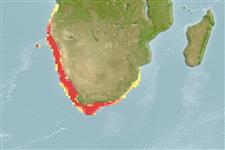Environment: milieu / climate zone / intervalo de profundidade / distribution range
Ecologia
marinhas batidemersal; oceanódromo (Ref. 51243); intervalo de profundidade 50 - 1000 m (Ref. 27121), usually 150 - 450 m (Ref. 27121). Deep-water; 11°S - 37°S, 5°E - 33°E (Ref. 58452)
Southeast Atlantic: Baie Farte, Angola around Cape to Natal, South Africa. Also found on Valdivia Bank (26°18'S, 6°20'E).
Length at first maturity / Tamanho / Peso / Idade
Maturidade: Lm 47.4 range ? - ? cm
Max length : 140 cm TL macho/indeterminado; (Ref. 6605); common length : 50.0 cm TL macho/indeterminado; (Ref. 1371)
Espinhos dorsais (total) : 1; Raios dorsais moles (total) : 47 - 54; Espinhos anais: 0; Raios anais moles: 37 - 41. Light brown above, silvery to white below (Ref. 6605).
Body shape (shape guide): elongated; Cross section: oval.
Found on the continental shelf and slope to depths over 1,000 m (Ref. 27121). Juveniles (to about 64 cm) feed on small crustaceans and small deep-sea fishes such as lanternfishes, whereas larger individuals feed chiefly on small hakes and jack mackerel (Ref. 1371); cannibalism is common (Ref. 27121). Migrates southward in the spring and northward in autumn (Ref. 1371). Breeds throughout the year, peaks of reproductive activity in August and September (Ref. 36731). Marketed smoked, frozen, and fresh on ice; eaten steamed, fried and baked (Ref. 9988).
Life cycle and mating behavior
Maturidade | Reprodução | Desova | Ovos | Fecundidade | Larvas
Cohen, D.M., T. Inada, T. Iwamoto and N. Scialabba, 1990. FAO species catalogue. Vol. 10. Gadiform fishes of the world (Order Gadiformes). An annotated and illustrated catalogue of cods, hakes, grenadiers and other gadiform fishes known to date. FAO Fish. Synop. 125(10). Rome: FAO. 442 p. (Ref. 1371)
Categoria na Lista Vermelha da IUCN (Ref. 130435: Version 2025-1)
Ameaça para o homem
Harmless
Utilização humana
Pescarias: pouco comercial
Ferramentas
Relatórios especiais
Descarregue XML
Fontes da internet
Estimates based on models
Preferred temperature (Ref.
123201): 7.7 - 14.4, mean 10.2 °C (based on 78 cells).
Phylogenetic diversity index (Ref.
82804): PD
50 = 0.5000 [Uniqueness, from 0.5 = low to 2.0 = high].
Bayesian length-weight: a=0.00513 (0.00339 - 0.00775), b=3.11 (2.98 - 3.24), in cm total length, based on LWR estimates for this species & Genus-body shape (Ref.
93245).
Nível Trófico (Ref.
69278): 3.9 ±0.65 se; based on food items.
Generation time: 9.2 (7.9 - 12.1) years. Estimated as median ln(3)/K based on 21
growth studies.
Resiliência (Ref.
120179): Baixo, tempo mínimo de duplicação da população 4,5 - 14 anos (K=0.07-0.13).
Fishing Vulnerability (Ref.
59153): High to very high vulnerability (67 of 100).
🛈
Climate Vulnerability (Ref.
125649): Very high vulnerability (86 of 100).
🛈
Nutrients (Ref.
124155): Calcium = 6.55 [3.45, 22.85] mg/100g; Iron = 0.282 [0.055, 0.771] mg/100g; Protein = 16.8 [15.7, 18.1] %; Omega3 = 0.123 [0.066, 0.231] g/100g; Selenium = 32.1 [14.4, 77.4] μg/100g; VitaminA = 9.09 [1.90, 42.59] μg/100g; Zinc = 0.225 [0.151, 0.358] mg/100g (wet weight);
